Creation care in worship and teaching
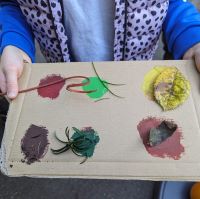 St Andrew's Clewer: St Andrew’s Clewer run Wild Worship every month. It includes churchyard trails throughout the liturgical year, nature trails, tree identification activities, wildflower hunting and nature crafting. The path throughout the churchyard becomes a display board, with chalk drawings for visitors to enjoy and a ‘finds’ table that is always full. The church has also just begun creation meditation, with people gathering early in the morning for the dawn chorus, to reflect on God’s creation.
St Andrew's Clewer: St Andrew’s Clewer run Wild Worship every month. It includes churchyard trails throughout the liturgical year, nature trails, tree identification activities, wildflower hunting and nature crafting. The path throughout the churchyard becomes a display board, with chalk drawings for visitors to enjoy and a ‘finds’ table that is always full. The church has also just begun creation meditation, with people gathering early in the morning for the dawn chorus, to reflect on God’s creation.
St Paul’s Wooburn: Paul Cudby has been integral to embedding creation care teaching into the life and worship of St Paul’s in Wooburn, particularly through Forest Church which allows people to come and worship in creation. The church is also a bronze eco church, and has established an environmental management policy for looking after their green spaces.
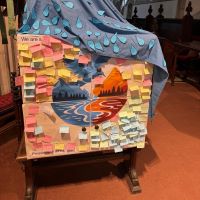 Vale of White Horse Deanery:The deanery gathers and prays weekly for creation care and their churches, and now 17 of the churches in the deanery have joined Eco Church, with 1 achieving the Silver award and 7 achieving bronze. All Saints Faringdon, the silver eco church, had a dedicated prayer space during creationtide last year, and run regular activities in their wildlife-friendly churchyard.
Vale of White Horse Deanery:The deanery gathers and prays weekly for creation care and their churches, and now 17 of the churches in the deanery have joined Eco Church, with 1 achieving the Silver award and 7 achieving bronze. All Saints Faringdon, the silver eco church, had a dedicated prayer space during creationtide last year, and run regular activities in their wildlife-friendly churchyard.
Church action for land and nature
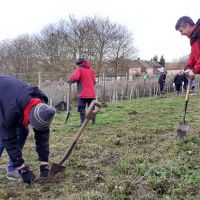 St Lawrence’s, Hungerford: has done enormous amounts of tree planting in partnership with local community groups, with well over 6,000 trees planted in the last few years. Some of the trees, provided by the Woodland Trust, form two new hedgerows near the churchyard. They are a Silver Eco Church.
St Lawrence’s, Hungerford: has done enormous amounts of tree planting in partnership with local community groups, with well over 6,000 trees planted in the last few years. Some of the trees, provided by the Woodland Trust, form two new hedgerows near the churchyard. They are a Silver Eco Church.
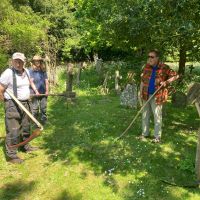 St Mary’s, Wargrave: is a Silver Eco Church and is doing great things in all five eco church categories. On land in particular, they conduct wildlife surveys - including plants, bugs, bats and reptiles - and take part in Churches Count on Nature. Five species of bat have been identified flying around St Mary's, and the south porch has been a registered natterer's bat roost. In St Mary's cemetery, which is adjacent to a small nature reserve, they have added a garden of remembrance, put bat boxes onto trees and spotted woodpeckers and tree creepers. They have a dedicated “Let It Grow” zone in St Mary's churchyard, and use traditional scything to cut the grass.
St Mary’s, Wargrave: is a Silver Eco Church and is doing great things in all five eco church categories. On land in particular, they conduct wildlife surveys - including plants, bugs, bats and reptiles - and take part in Churches Count on Nature. Five species of bat have been identified flying around St Mary's, and the south porch has been a registered natterer's bat roost. In St Mary's cemetery, which is adjacent to a small nature reserve, they have added a garden of remembrance, put bat boxes onto trees and spotted woodpeckers and tree creepers. They have a dedicated “Let It Grow” zone in St Mary's churchyard, and use traditional scything to cut the grass.
Holy Trinity Wolverton and St George’s Wolverton: In the last few months have both achieved the Bronze Eco Church award, following hard work by their churchyard leads. At Holy Trinity the churchyard lead is Terry Collier and at St George's church it is Neil Harris. They have created and nurtured groups of volunteers - both church members and local people from the community, who regularly come to look after their outside spaces. At Holy Trinity they meet every week and at St George's they meet on the first Saturday of the month. They have both established nature and wildflower areas within the churchyards and have been extremely dedicated to making sure that the churches are the envy of many!
St Andrew’s Headington: Jane Shepherd has been nominated as a champion for land and nature, for her work to rewild the churchyard, which now has more than 10 varieties daffodils (and more than a thousand daffodils in the spring) that bloom across 3 months and attracts numerous pollinators. She has planted a herb garden near the entrance for the local community, and has set up Young Church, teaching children about animals and plants, and creating a Young Church garden where their children grow vegetables and fruits all year round.
All Saints, Wokingham: is another Silver Eco Church which has installed a bug hotel, bird boxes, and created bat friendly areas in the churchyard. They leave holly and ivy to grow as shelter for insects over winter and spring, as well as leaving areas of churchyard un-mown, as a summer meadow. They have refurbished an old cast iron hand pump in the churchyard which can be used to pump water from a rainwater sump. And they are encouraging schools and young uniformed groups to participate in bug-hunts and nature days in the churchyard. Finally, they have created a regular monthly Wild Worship service in the churchyard; an outdoor service open to all ages, in which they celebrate God’s creation, whatever the weather!
St Francis Terriers, Wycombe: in an urban area of High Wycombe, St Francis Terriers have turned a neglected area of land into a community garden for church members and local people. It serves as both a quiet, reflective space for contemplation, a place where people can meet and spend time together amongst the greenery, and is also used for worship in the life of the church.
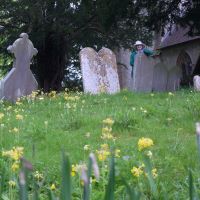 St Andrew’s, Letcombe Regis: St Andrew’s is featured on the Caring for God’s Acre website as a case study in churchyard management. Over the past few years, the large wildflower section of the churchyard has become the passion of one lady, Anne Williams, who has tended the village verges and communal areas so that there is now an annual display of wildflowers along those as well, especially snowdrops and primroses. She collects seed from wildflowers of the local chalkland area, tends them at home and then plants them in the wildflower area to enrich the biodiversity. They have a wide range of wildlife in all three areas of the churchyard.
St Andrew’s, Letcombe Regis: St Andrew’s is featured on the Caring for God’s Acre website as a case study in churchyard management. Over the past few years, the large wildflower section of the churchyard has become the passion of one lady, Anne Williams, who has tended the village verges and communal areas so that there is now an annual display of wildflowers along those as well, especially snowdrops and primroses. She collects seed from wildflowers of the local chalkland area, tends them at home and then plants them in the wildflower area to enrich the biodiversity. They have a wide range of wildlife in all three areas of the churchyard.
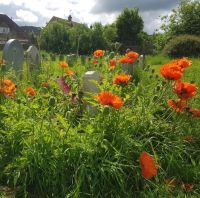 Chinnor Churches: This group of churches has formed ‘Chinnor Churches Go Wild’ and are an A Rocha UK Partner in Action. Wildflowers and areas of long grass left unmown in the churchyards have provided habitat for wildlife including slow worms, grass snakes, swifts, bats, hedgehogs, and several butterfly and bee species.
Chinnor Churches: This group of churches has formed ‘Chinnor Churches Go Wild’ and are an A Rocha UK Partner in Action. Wildflowers and areas of long grass left unmown in the churchyards have provided habitat for wildlife including slow worms, grass snakes, swifts, bats, hedgehogs, and several butterfly and bee species.
The group also organise environmental events for the whole community to be involved in, such as flower festivals, churchyard surveys, children and family events, bird and bat walks, and has hosted a recent Forest Church in the churchyard at St Andrew’s Church.
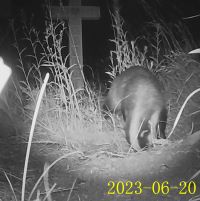 Holy Trinity, Prestwood: another case study on the Caring for God’s Acre site, Holy Trinity Churchyard, Prestwood, is a rare survival of the original acid grass heath that was prevalent on the extensive old Chiltern commons that were almost entirely destroyed when enclosed in the middle of the 19th century. Plants survive here that are no longer known anywhere else in the region. In addition, the combination of no fertilisers, regular mowing and removal of cuttings, has created the ideal conditions for what is known as a “waxcap grassland”, where a special suite of fungi that are largely very rare, can flourish.
Holy Trinity, Prestwood: another case study on the Caring for God’s Acre site, Holy Trinity Churchyard, Prestwood, is a rare survival of the original acid grass heath that was prevalent on the extensive old Chiltern commons that were almost entirely destroyed when enclosed in the middle of the 19th century. Plants survive here that are no longer known anywhere else in the region. In addition, the combination of no fertilisers, regular mowing and removal of cuttings, has created the ideal conditions for what is known as a “waxcap grassland”, where a special suite of fungi that are largely very rare, can flourish.
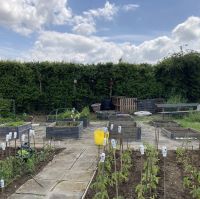 St Peter’s Quarrendon: Their Community Garden was set up in 2019, providing pesticide-free food and crops to people as well as wildlife. It is an example of how green spaces can be used for social and health benefits, alongside the benefits for nature. Graham Woodhouse teaches newcomers from the community to get involved in the care of the garden and assists with an after-school community 'Gro-Outdoors' project, centred on school age children where they learn how to grow and care for crops, and the importance of taking care of the nature that is already surrounding us. Ros John has used her skills in handicraft and cooking to teach the young children to see following God’s biblical teaching also enhances our environment. Dave Furze heads up the community garden and is now helping other churches as well as the local area to see how they can develop their own.
St Peter’s Quarrendon: Their Community Garden was set up in 2019, providing pesticide-free food and crops to people as well as wildlife. It is an example of how green spaces can be used for social and health benefits, alongside the benefits for nature. Graham Woodhouse teaches newcomers from the community to get involved in the care of the garden and assists with an after-school community 'Gro-Outdoors' project, centred on school age children where they learn how to grow and care for crops, and the importance of taking care of the nature that is already surrounding us. Ros John has used her skills in handicraft and cooking to teach the young children to see following God’s biblical teaching also enhances our environment. Dave Furze heads up the community garden and is now helping other churches as well as the local area to see how they can develop their own.
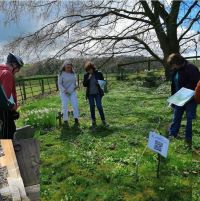 St James the Greater, Eastbury: St James’s has focused on efforts to support biodiversity in their churchyard, allowing areas of grass to grow longer and using QR codes so that people can learn more about wildlife and biodiversity. They have built networks with local community organisations, and participated in the Lambourn Valley Big Green Weekend, working with the churches across the valley to host talks and activities, such as apple pressing, a foraging walk and an eco-display.
St James the Greater, Eastbury: St James’s has focused on efforts to support biodiversity in their churchyard, allowing areas of grass to grow longer and using QR codes so that people can learn more about wildlife and biodiversity. They have built networks with local community organisations, and participated in the Lambourn Valley Big Green Weekend, working with the churches across the valley to host talks and activities, such as apple pressing, a foraging walk and an eco-display.
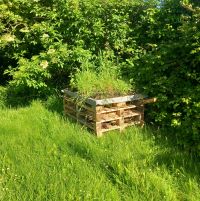 St Mary’s in North Leigh, has been working hard on a churchyard management plan enabling biodiversity to thrive, which has made it onto Witney radio.
St Mary’s in North Leigh, has been working hard on a churchyard management plan enabling biodiversity to thrive, which has made it onto Witney radio.
Buildings
 St Andrew’s, Sandford-on-Thames: is a Grade II* listed church which, several years ago installed a ground source heat pump to provide renewable heat to the church. The church maintains a temperature of between 17 and 18 degrees all year round, with no supplementary heating required. They were one of the first churches in our diocese to adopt this technology.
St Andrew’s, Sandford-on-Thames: is a Grade II* listed church which, several years ago installed a ground source heat pump to provide renewable heat to the church. The church maintains a temperature of between 17 and 18 degrees all year round, with no supplementary heating required. They were one of the first churches in our diocese to adopt this technology.
All Saints, Dedworth: Peter Norris has overseen a programme of energy efficiency improvements to the church, which has seen their carbon emissions reduce by 7 tonnes a year over the last 4 years. They have installed LED lights, insulation and draught-proofing, and have carefully monitored energy use so that it can be timed and managed for the greatest efficiency.
St Mary’s Wendover: have replaced their doors with a new porch including automatic doors, that keep the cold out and the heat in. They have installed LED lights, installed smart meters and switched things off when not in use, all of which has resulted in a halving of their energy consumption over the last 5 years. They are now looking into a large-scale project that would include a replacement heating system, powered by a heat pump.
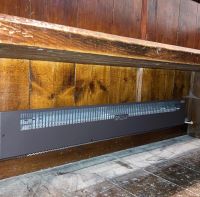 All Saints, North Moreton: had an energy audit and implemented the recommendations in the report to carry out energy efficiency improvements to their lighting, as well as installing under pew heating. This solution has been a game-changer for comfort in the church, which was previously heated by over-head heaters that managed to keep the roof really warm, but not so much the people.
All Saints, North Moreton: had an energy audit and implemented the recommendations in the report to carry out energy efficiency improvements to their lighting, as well as installing under pew heating. This solution has been a game-changer for comfort in the church, which was previously heated by over-head heaters that managed to keep the roof really warm, but not so much the people.
Community and Global Engagement
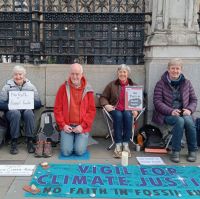 St John’s and St Stephen’s, Reading: St John’s and St Stephen’s have been active in advocacy for many years, attending national climate marches in London, joining prayer vigils, handing out leaflets locally, and engaging with the local MP regularly. Joanna Laynesmith founded the Reading branch of Green Christians, and is organizing a hustings for this year’s general elections. The church is a silver eco church, and working towards Gold.
St John’s and St Stephen’s, Reading: St John’s and St Stephen’s have been active in advocacy for many years, attending national climate marches in London, joining prayer vigils, handing out leaflets locally, and engaging with the local MP regularly. Joanna Laynesmith founded the Reading branch of Green Christians, and is organizing a hustings for this year’s general elections. The church is a silver eco church, and working towards Gold.
St Paul’s, Wokingham: Andy Clark, church member at St Paul’s, organised a popular and successful series of lectures in Wokingham last Autumn, and did a great job of bringing groups together and getting conversations around climate change onto the radar. It was a lot of work and it went really well, and attracted a lot of people and some excellent speakers too…
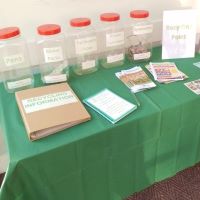 St Barnabas, Emmer Green: Since the church registered for Eco Church in autumn 2023, Christine Bartlett has been a whirlwind of enthusiasm and action. Thanks to her leading in this area, the church was awarded a Bronze Eco Church award in October 2023 and they expect to be able to apply for a Silver award this summer. Christine set up a recycling station in the church porch that is well used by church members and the wider community. She continues to develop and ‘tend’ the recycling area and has recently started work on a new project of creating a wildlife garden at the rear of the church in an area previously unused and unloved. Christine’s gentle leadership is bringing other leaders and members of the church to support the creation care work of the church.
St Barnabas, Emmer Green: Since the church registered for Eco Church in autumn 2023, Christine Bartlett has been a whirlwind of enthusiasm and action. Thanks to her leading in this area, the church was awarded a Bronze Eco Church award in October 2023 and they expect to be able to apply for a Silver award this summer. Christine set up a recycling station in the church porch that is well used by church members and the wider community. She continues to develop and ‘tend’ the recycling area and has recently started work on a new project of creating a wildlife garden at the rear of the church in an area previously unused and unloved. Christine’s gentle leadership is bringing other leaders and members of the church to support the creation care work of the church.
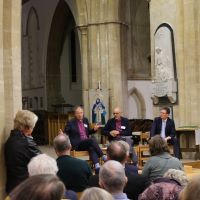 Mary’s, Witney & the Witney Benefice: Kate Banks is a member of St Mary’s Witney, and founded the Witney Eco Forum in partnership with other local organisations. Every month they host evenings in the church, with external speakers talking on a range of environmental topics – from the Botley west solar farm, to wildlife, and sewage. They recently held a meeting with former MP Chris Skidmore, author of the Net Zero Review, to hold the government to account on their net zero progress, and also a hustings as part of the May local elections.
Mary’s, Witney & the Witney Benefice: Kate Banks is a member of St Mary’s Witney, and founded the Witney Eco Forum in partnership with other local organisations. Every month they host evenings in the church, with external speakers talking on a range of environmental topics – from the Botley west solar farm, to wildlife, and sewage. They recently held a meeting with former MP Chris Skidmore, author of the Net Zero Review, to hold the government to account on their net zero progress, and also a hustings as part of the May local elections.
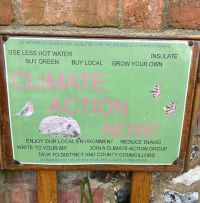 The Churn Benefice: George Curtis is deeply committed to and passionate about political advocacy for the environment, regularly engaging his local MP and holding them to account. He was a founding member of Churn Churches Climate Action, has attended training by Hope for the Future on political advocacy, and speaks up for creation care issues through local groups and events.
The Churn Benefice: George Curtis is deeply committed to and passionate about political advocacy for the environment, regularly engaging his local MP and holding them to account. He was a founding member of Churn Churches Climate Action, has attended training by Hope for the Future on political advocacy, and speaks up for creation care issues through local groups and events.
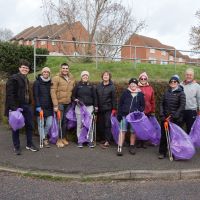 St Andrew’s, High Wycombe: St Andrew’s has set up Creation Crew, a missional community that spends time outside caring for creation through litter picks, local conservation activities, and prayer. They have run swap shops, managed their churchyard for biodiversity and worked with their youth to plant native hedge in the church garden. They recently achieved their Silver Eco Church Award.
St Andrew’s, High Wycombe: St Andrew’s has set up Creation Crew, a missional community that spends time outside caring for creation through litter picks, local conservation activities, and prayer. They have run swap shops, managed their churchyard for biodiversity and worked with their youth to plant native hedge in the church garden. They recently achieved their Silver Eco Church Award.
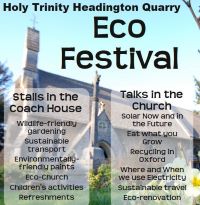 Holy Trinity, Headington Quarry: The Eco Church team is headed up by Hilary Rolin and Jan McLeod, who have worked tirelessly to achieve the silver eco church award. They run regular events on different environmental topics, ran Climate Conversations with members of the congregation, deliver Forest Church services, host a community car-share scheme, and run nature walks. They have also been involved with plans to improve the energy efficiency and long-term heating needs of the church.
Holy Trinity, Headington Quarry: The Eco Church team is headed up by Hilary Rolin and Jan McLeod, who have worked tirelessly to achieve the silver eco church award. They run regular events on different environmental topics, ran Climate Conversations with members of the congregation, deliver Forest Church services, host a community car-share scheme, and run nature walks. They have also been involved with plans to improve the energy efficiency and long-term heating needs of the church.
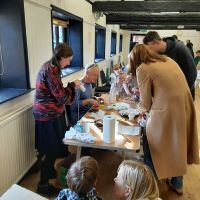 Burchetts Green, Benefice: is a benefice in Maidenhead and Windsor, in which all churches have now achieved the Bronze award. Recently, Eco Church Lead and Deanery Environmental Lead, Hannah Etherton, ran a Wildlife Saturday for the local community. 90 people attended including 35 children, for nature-based crafts and activities. Hannah engaged a local nature group, Bisham Nest Box Group, to help them make nest boxes, she made wildflower seed paper, and seed balls for birds using basic resources, which was a very popular activity. The churches are participating in Churches Count on Nature this week.
Burchetts Green, Benefice: is a benefice in Maidenhead and Windsor, in which all churches have now achieved the Bronze award. Recently, Eco Church Lead and Deanery Environmental Lead, Hannah Etherton, ran a Wildlife Saturday for the local community. 90 people attended including 35 children, for nature-based crafts and activities. Hannah engaged a local nature group, Bisham Nest Box Group, to help them make nest boxes, she made wildflower seed paper, and seed balls for birds using basic resources, which was a very popular activity. The churches are participating in Churches Count on Nature this week.
St Michael and All Angels, Summertown: St Michael’s have worked hard to engage the local congregation and community in creation care, taking a display into the town for people to engage with, running events in the church for the local community, and inviting the congregation to sign a covenant for creation. This involved making personal pledges to change something in their own lives as well as thinking about how the church can be a transformative force in the community.
Christ the Cornerstone, Milton Keynes: In the last few years, Stuart Kean, deanery environmental lead for Milton Keynes, has been engaging churches of all denominations across the deanery in creation care. He began with an Eco Church workshop last summer, attended by well over 20 churches from the local area, and has since hosted another learning workshop for the Milton Keynes Methodist Circuit. Within the Anglican Eco Church network, virtually all the churches now have bronze awards. He has supported an event run by Milton Keynes Climate Action Network and hosted by Cornerstone, offering talks and stalls on environmental issues.
Our Link Dioceses
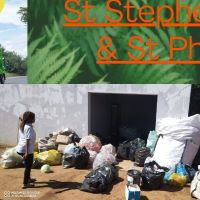 In our link Diocese of Kimberley and Kuruman, St Stephen’s and St Philip’s Church have focused on a big community recycling project. Plastic waste and litter is a huge problem in Kimberley, and this church is seeking to both practically address the problem, whilst also changing hearts and minds within the congregation.
In our link Diocese of Kimberley and Kuruman, St Stephen’s and St Philip’s Church have focused on a big community recycling project. Plastic waste and litter is a huge problem in Kimberley, and this church is seeking to both practically address the problem, whilst also changing hearts and minds within the congregation.
And in the Diocese of Vaxjo, the parish of Ljunby are focusing on increasing the biodiversity in their cemetery, by planting flowers that will attract pollinators, turning off the church tower lights at night to help bats and moths, and creating nesting spots for wildlife such as sand beds for wild bees, insect hotels, birdhouses and bat boxes. They also collect rainwater in butts for watering.
Schools
St Paul’s Junior, Wokingham: the team running Forest School at St Paul’s Junior School do an amazing job in ensuring that every pupil gets to spend time in the woods, exploring nature, learning new skills and really growing in confidence. Those students in particular, who feel squashed and limited by the classroom, are blossoming at Forest School and really reveal themselves and relax. It is a wonderful experience to be part of it and it adds to the quality of the education we provide at the school while also teaching a real love and understanding of nature.
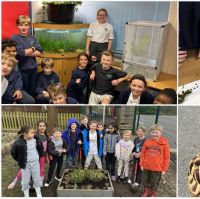 St Mary’s Shinfield: A shining light for creation care, this school has planted 5,000 trees in 5 years, they grow produce in 24 raised beds and Children are taught the fundamentals of sustainable growing and all produce gets donated to local food banks. They have an aquaponic biodome where children are taught how to farm fish and vegetables in the same system. They’ve constructed an artificial wildlife stream to provide essential water for local animals, and have several bird boxes, bat boxes, owl boxes, insect hotels and log piles to help our wild friend. They have a community tree nursery where they collect, store and then grow trees for community projects. And finally, they are a carbon neutral school, with 114 solar panels and are soon to have an air source heating system installed.
St Mary’s Shinfield: A shining light for creation care, this school has planted 5,000 trees in 5 years, they grow produce in 24 raised beds and Children are taught the fundamentals of sustainable growing and all produce gets donated to local food banks. They have an aquaponic biodome where children are taught how to farm fish and vegetables in the same system. They’ve constructed an artificial wildlife stream to provide essential water for local animals, and have several bird boxes, bat boxes, owl boxes, insect hotels and log piles to help our wild friend. They have a community tree nursery where they collect, store and then grow trees for community projects. And finally, they are a carbon neutral school, with 114 solar panels and are soon to have an air source heating system installed.
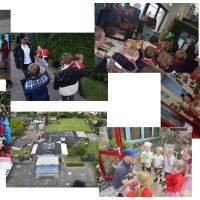 Marlow CofE Infants School: In September 2019, the Eco Warriors at Marlow C of E Infant School asked the Governors of the school to declare an environmental and climate emergency on their behalf. As a Green Flag school, they have been Looking for different ways to save, recycle and reuse the Earth’s precious resources, they are courageous advocates for the preservation of the environment and particularly habitats and they are finding alternative ways to save energy. They have a Wild World at the school, which has created habitats for wildlife and mini-beasts, they run a walk to school campaign and they have a dedicated area for outdoor learning.
Marlow CofE Infants School: In September 2019, the Eco Warriors at Marlow C of E Infant School asked the Governors of the school to declare an environmental and climate emergency on their behalf. As a Green Flag school, they have been Looking for different ways to save, recycle and reuse the Earth’s precious resources, they are courageous advocates for the preservation of the environment and particularly habitats and they are finding alternative ways to save energy. They have a Wild World at the school, which has created habitats for wildlife and mini-beasts, they run a walk to school campaign and they have a dedicated area for outdoor learning.
Christ the Sower, Milton Keynes has mapped an entire green curriculum that incorporates teaching about sustainability and caring for the planet from the beginning of a child’s primary school journey, to the end. They have recently run an Earth Day with all sorts of activities for the children.
The young green teams at St Andrew’s Church of England Primary, and St Mary and St John’s Primary, both in Oxford, are recognized for their commitment, passion and hard work to embed creation care in the life of their schools, taking on leadership roles and engaging with the adults.
The Marlborough School in Blenheim, has been working with their young people to enable community activities such as litter-picks, embedding green issues in the curriculum, and striving to ensure creation care is a school priority.
And our link school in Nandyal, the Church of South India Primary School, is using creative ways to introduce environmental issues to their students, especially through dance.
